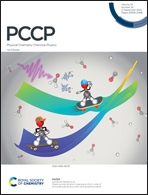Thermoelectrochemical Seebeck coefficient and viscosity of Co-complex electrolytes rationalized by the Einstein relation, Jones–Dole B coefficient, and quantum-chemical calculations†
Abstract
The Seebeck coefficient (Se) and the viscosity of a redox electrolyte are the key characteristics of thermoelectrochemical cells that generate electric power from waste thermal energy. However, the recent upsurge of research in this field is seriously disconnected from the knowledge of solution chemistry explored in the previous century. Herein, we systematically investigate five redox couples of cobalt complexes containing different aromatic ligands and anions in γ-butyrolactone solvent to demonstrate how the Einstein relation of hydrodynamic theory and the Jones–Dole B coefficient obtained from viscosity measurements can be used to account for such electrolyte properties. In essence, we reveal that the outer-shell (solvent reorganization) and inner-shell (metal–ligand reorganization) contributions to the redox reaction entropy ΔSrc (∝Se) can be quantified by the analyses using the B-coefficients and quantum-chemical simulations, respectively, while the distinct regimes found in the viscosity and conductivity are well accounted for by the Einstein relation, despite its classical hydrodynamic origin.



 Please wait while we load your content...
Please wait while we load your content...